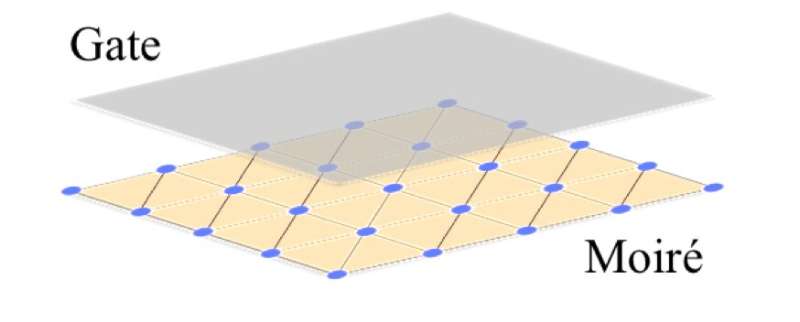September 22, 2021 feature
Researchers achieve charge-order-enhanced capacitance in semiconductor moiré superlattices

In recent years, electronics engineers have been experimenting with new materials that could be used to study electronic correlation phenomena. Van der Waals (vdW) moiré materials are particularly promising for examining these phenomena. VdW materials are composed of strongly bonded two-dimensional (2D) layers that are bound in the third dimension through weaker dispersion forces.
The term moiré, on the other hand, refers to a specific pattern produced when an opaque ruled pattern with gaps is placed onto a similar pattern. Studies have recently unveiled robust and correlated insulating states at both integer and fractional filling factors of semiconducting materials with a moiré pattern.
Researchers at Cornell University and the National Institute for Materials Science in Japan have recently carried out a study exploring the thermodynamic properties of these robust correlated states. Their paper, published in Nature Nanotechnology, ultimately showed that capacitance (i.e., the ability of a system to store electric charge) can play a key role in probing correlated states of semiconductor moiré materials.
This recent study was in part based on a previous research effort by the same team, which unveiled the presence of an abundance of electron crystals in semiconductor moiré materials. One of the main objectives of the team's new study was to better understand these electron crystal states by collecting thermodynamics measurements.
"Our study also draws inspiration from theoretical calculations by our friend Veit Elser, who is a co-author in the paper," Kin Fai Mak, one of the researchers who carried out the study, told TechXplore. "Veit calculated the capacitance for a parallel plate capacitor that has the sample as one plate and a metallic gate as another plate."
Typically, the capacitance of a parallel plate capacitor such as the one investigated by Elser would only be defined by its geometry (e.g., the distance between the two plates). Surprisingly, however, his calculations suggested that the capacitance when the sample plate is in a phase mixture of electron crystals could in fact be infinite.
"This could be huge, as it can significantly enhances the capability of the device to store charge," Mak said.
To test this idea experimentally, Mak and his colleagues measured the capacitance of a parallel capacitor that has the sample of interest (i.e., the moiré sample) as one plate and a thin sheet of metal as the second plate.
"The two plates were separated by an experimentally variable distance," Mak said. "The capacitance is intimately connected to the electronic compressibility (a thermodynamic quantity) of the sample, which is a measure of how compressible the electrons are when they are subjected to an external electric field."
The team carefully measured how compressible the electrons in their sample were when exposed to an external electric field as a function of electron density and temperature. This allowed them to derive two additional thermodynamic measurements (i.e., the electronic entropy and specific heat capacity) from the existing data, using renowned and established rules of thermodynamic relations.
"One of the most important achievements of our study was a significant enhancement of the measured capacitance compared to the geometrical value," Mak said. "To the best of our knowledge, this is probably the largest enhancement reported to date. Because of sample disorders, however, the observed enhancement is far from infinity as predicted by Veit's original calculations. One could imagine further capacitance enhancement with better samples in the future."
The recent findings gathered by this team of researchers could have important implications for the development of electronic devices. In fact, their work demonstrates that the capacitance of semiconductor moiré superlattices can be significantly enhanced, which means that the charge storage of devices made of these materials could be improved.
In addition, the team gathered valuable quantitative measurements of the thermodynamic properties of the electron crystal states in semiconductor moiré superlattices. In the future, these measurements could help to better understand the nature of these exotic states of matter.
"Thermodynamic measurement is an important skill in physics, as it helps understand the nature of many emergent quantum states of matter," Mak added. "There are so many exotic states recently discovered in moiré materials (e.g., superconductivity, correlated insulators, electron crystals, quantum anomalous Hall effect, etc.). Carrying out thermodynamic studies on these states will certainly help understand some of the mysteries in this field of research. In general, capacitance measurement is a very useful diagnostic tool for quantum matters."
More information: Tingxin Li et al, Charge-order-enhanced capacitance in semiconductor moiré superlattices, Nature Nanotechnology (2021). DOI: 10.1038/s41565-021-00955-8
Yang Xu et al, Correlated insulating states at fractional fillings of moiré superlattices, Nature (2020). DOI: 10.1038/s41586-020-2868-6
Journal information: Nature Nanotechnology , Nature
© 2021 Science X Network




















